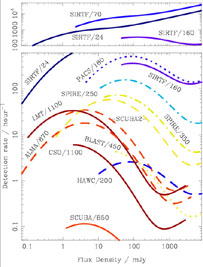


7.3. Future capabilities and progress
The enhanced capabilities of this array of new facilities is illustrated in Fig. 23. The rate at which galaxies can be detected is likely to grow dramatically from a few per day at present to many hundreds per hour. Note that the various instruments operate at different wavelengths, and so each is most sensitive to galaxies at different redshifts and with different luminosities. However, sample sizes are certain to increase dramatically, especially when the 104-105 galaxies that will be detected in the Planck Surveyor all-sky survey are taken into account.
 |
Figure 23. The detection rates expected in
a variety of forthcoming mm, submm and far-IR surveys.
The names and wavelengths in microns of the relevant instruments
are listed: see Tables 1 and
2.
The higher- and lower-peaking SCUBA-II curves correspond to wavelengths
of 450 and 850 µm respectively. References
to instrument performance for these calculations
(Blain and Longair, 1996)
can be found in Table 3. The surface
density of galaxies assumed follows the models of
Blain et al. (1999b):
see Figs. 9 and
10. Curves stop on the
right if the surface density is expected to fall below a single galaxy
on the whole sky. Curves stop at the left when a relatively optimistic
definition of the 5 |
Multiwavelength follow-up observations of all these new submm galaxies are likely to remain a time-consuming challenge. However, the likely availability of 30-m-aperture ground-based optical/near-IR telescopes in the next decades, and the extremely deep imaging capability of NGST, should help us to study a complete sample of submm galaxies down to luminosities that are only a fraction of L*.